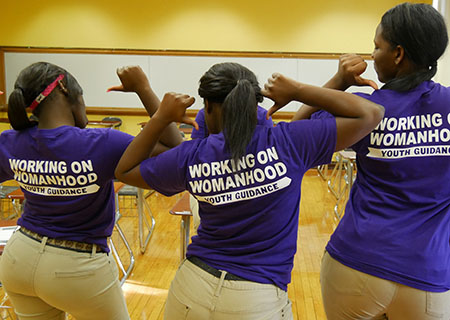Better decision-making for teens
COVID-19 restrictions, including requirements for physical distancing, have had a profound effect on youth and young adults. During a critical time for social-emotional development, they have been among the most vulnerable to increased psychological stress.[1] Two Youth Guidance programs, Becoming A Man (BAM) and Working on Womanhood (WOW), support youth who are at elevated risk of making poor choices, given a history of family trauma, troubled academics or school behavior, and ubiquitous neighborhood violence.
What It Does
Becoming A Man (BAM) and Working on Womanhood (WOW) work with small groups of 12 to 15 students in grades 7 through 12 to develop decision-making skills, especially those related to issues such as violence, relationships, dropping out of high school, and criminal activity.
Since girls and boys often face different problems and deal with them differently, Youth Guidance runs separate programs for each gender. Both involve weekly, small-group, interactive sessions during the school day that allow for individual mentoring, group exercises, and experiential learning. These sessions give students a chance to problem-solve with peers and a professional counselor in a nonjudgmental setting. BAM and WOW serve more than 10,000 youth in 164 schools, many are among the most challenged schools in their areas. Youth Guidance delivers BAM and WOW jointly in Boston, MA; Chicago, IL; Dallas, TX; Kansas City, MO. Additionally, BAM is delivered in King County, WA; London, UK; Los Angeles, CA, and Washington, DC.
During the pandemic, Youth Guidance adapted BAM and WOW for virtual implementation using district-approved platforms. Counselors focused on individual support services for youth and their families. They also responded to acute needs including financial distress and food insecurity, healthcare, housing, and access to technology. BAM and WOW resumed in-person programming in Fall 2021.
How Effective It Is
A 2017 independent study of BAM showed large reductions in criminal activity and improved academic outcomes.[2][3] Over a year-long period, BAM participants were 50% less likely to be arrested for a violent crime than students in a randomly assigned comparison group and 19% more likely to graduate high school on time. Since incarceration is so expensive, the study estimated a social return of up to $30 for every $1 invested, based on crime reduction alone. When participants graduate from high school, the increases in earnings and decreases in reliance on social services add to that return on investment.[4]
An independent evaluation of WOW in 2019 which found that 24% of participants with clinical symptoms of Post-Traumatic Stress Disorder (PTSD) experienced reduction in those symptoms while in the program. Internal evaluation results have also been encouraging: 71% of participants who started the school year in the clinically-significant range for depression experienced a decrease in symptoms within a year. WOW monitors girls’ improvement in their program using the adolescent Patient Health Questionnaire Depression Index and Difficulties in Emotional Regulation Scale.
How You Can Help
Any amount can contribute to the $2,500 per student it costs to provide BAM or WOW for a year of either program. Funders can also sponsor a 12-15 person BAM or WOW group for $10,000 per year, or an entire school (55 kids) for $25,000 per year. $30,000 funds expansion to a new district that is adjacent to an existing site. Learn more at: https://www.youth-guidance.org/standard-donation/
More Ways to Help — Another organization that seeks to improve adolescent decision-making is The Brotherhood/Sister Sol in New York, which provides long-term support services for youth focused on preparing for the future. Pace Center for Girls emphasizes both academic and social services for middle- and high-school aged girls and young women. The program offers individualized learning and counseling plans and has garnered national recognition as one of the most effective programs in the country for keeping girls from entering the juvenile justice system.

